Öhlins TTX22M Rear Shock
| Where To Buy | |||
|---|---|---|---|
Free shipping on orders over $50 (continental U.S. only).
International shipping available. Some exclusions apply. |
Free shipping on orders over $50 (continental U.S. only).
International shipping available. Some exclusions apply. $549.00
|
||
Free shipping on orders over $50 (continental U.S. only).
International shipping available. Some exclusions apply. |
|||
Review by Brandon Turman // Photos by Cameron Baird, Specialized, & Brandon Turman
If you want to cause a stir in the bike industry, one surefire way to do it is a bright yellow shock in a sea of black. What does yellow mean in the suspension world? It means Öhlins is here, and they mean business.

After more than one year of testing, tweaking, and tuning, a collaboration between Specialized and Öhlins has yielded the TTX (Model # TTX22M), a shock specifically tuned for Specialized's big-hitting gravity bikes. We had the opportunity to ride a 2014 Demo 8 equipped with the shock at the Val di Sole World Cup, but before we jump into our ride impressions, let's step back and learn a bit more about Öhlins, how and why the partnership came to be, and just what makes this thing so special.
A Brief History Of Öhlins
Founded by Kenth Öhlin in 1976, a motorcycle racer himself, Öhlins began as a Swedish retailer for motorbikes and mopeds, while also making exhaust pipes, engines, and shock absorbers. Things quickly took off for the company, forcing them to consolidate their efforts. It was then that they chose to focus on suspension. In 1978, just two years after the company was born, they claimed their first motorsports World Championship under Russian motocross racer, Gennady Moiseev.
The company continued to push into the motocross scene into the 1980's, winning several more World Championship Titles along the way. In 1987, Kenth Öhlin sold half of the company to Yamaha, seeing a major opportunity for collaboration and expansion. It was then that Öhlins made a bigger push in asphalt racing, and they were immediately met with good results. Later, in 2007, Kenth Öhlin decided to repurchase the majority share of the company.
Throughout the late 1980's, 1990's, and into the 2000's, Öhlins continued to expand, working alongside the best teams in the racing scene in every major motorsports discipline from Formula One to GT racing, MotoGP, and motocross. For the racers out there, perhaps the most interesting story is Öhlins' sponsorship policy. They don't sponsor anyone, even the world's best. If a team or rider wants Öhlins performance, they've always had to pay for it - a stark contrast to what we're accustomed to in the mountain bike industry.
Around 2005, Öhlins served as a consultant to Cane Creek, helping to develop their Double Barrel shock using the Twin Tube design and briefly touching the world of MTB. Cane Creek then took the shock to production, independent of Öhlins.

Fast-forward to today and the company has subsidiaries all over the world, 230 employees, is making good strides in the high-end automotive world with their Continuously Controlled Electronic Suspension system, and has amassed 200+ World Championships. They also re-invest 16% of their yearly turnover into the development of new products, like the first in-house bicycle shock you see before you today. While Kenth Öhlin is no longer directly involved in the design of new products, you can still find the founder on the factory floor daily.
Partnering With Specialized
A little over one year ago, Specialized Suspension Director, Mike McAndrews, met with Kenth Öhlin and the two tossed around the idea of working together on a new bicycle product. A few test rides later, Specialized saw promise in the early prototype and decided to pursue the partnership.
Looking back through the years, it quickly becomes clear that it has been quite some time since a partnership has happened like this, especially since it's Öhlins' first true push into the mountain bike market. Over the past 12 months, they co-developed a new shock specifically for the Demo 8 and Enduro EVO platforms - the TTX22M. This opportunity removed all limits on the amount of tweaking and tuning that could be made to the shock, and Specialized proceeded to work with Öhlins in co-creating what they see as the best shock possible for their bikes.

The 2014 Specialized S-Works Demo 8 Carbon
Öhlins TTX Shock Highlights
- Patented Twin Tube design
- High-speed compression adjustment (3-clicks)
- Low-speed compression adjustment (16-clicks)
- Low-speed rebound adjustment (7-clicks)
- Nitrogen-filled nitrile rubber reservoir bladder system
- Steel springs available in 23-pound (4 N/mm) increments
- Weight: ~460 grams without spring, plus additional 550-600 grams with spring
- Will fit 2012-2014 Specialized Demo 8 and 2013-2014 Enduro EVO bikes
- Upgrade program available through Specialized retailers
- MSRP: $799.99 (Shock body) // $49.99 (Springs)
Inside The TTX
Ready for this? It's about to get techy up in here…

When the Öhlins TTX is actuated, the fluid inside is forced to flow through two types of orifices: bleed valves and shim valves. Bleed valves (Fig.1) are small orifices that create a flow restriction simply by being small. Shim valves (Fig.2) use fluid pressure to deflect thin steel washers (shims) to open up an orifice and allow fluid to flow through it. To control damping force, the bleed valves can be changed in size by the external compression and rebound adjusters.

When the bike is compressed (Fig.3), the fluid above the piston is pressurized and has to move. It has three different escape routes:
- Piston compression shim valve
- Compression adjuster bleed valve
- Compression adjuster shim valve
The fluid flows through all these routes during every compression, but at low damper velocities the percentage going through the bleed valve is higher and at higher velocities the shim valves take care of most of the flow. During compression movement, the piston rod volume enters the main body and the corresponding volume of damper fluid flows into the reservoir through the compression valve, the bladder compresses, and this results in an increased gas pressure.
When the spring forces the shock to rebound (Fig. 4), the fluid below the piston is pressurized and forced to move. Due to the one-way check valve design on the outer tube, all fluid is forced to flow through the piston where it takes two different routes:
- Piston rebound shim valve
- Rebound adjuster bleed valve
The fluid that was displaced into the reservoir during compression movement is now pushed back into the main body by the gas pressure.
During both compression and rebound, the gas pressure supports the low-pressure side of the piston to keep pressure at a controlled level. This is what makes the Öhlins design so special, as it ensures consistent damping performance and improves damping response. In a traditional absorber, without the Twin Tube design, all fluid has to go through the main piston and the volume displaced by the piston goes to the gas reservoir. When this occurs, there is a higher pressure on the compression side of the shim stack and lower pressure on the other. Öhlins plays with what oil goes where to eliminate that pressure difference. Adjusting the compression settings changes the percentage of fluid that goes through the piston versus what goes around the bypass tube.

Why is this beneficial? It all comes down to response time. In traditional shocks, oil is getting compressed to a greater extent, and when you switch from compression to rebound, the oil has to expand as well (that squishy noise you often hear). Because of the Twin Tube design, internal pressure changes are less dramatic, which enables the shock to reverse directions quickly while maintaining consistent damping, even on very short stroke movements. Öhlins says that creating damping force at lower pressures has a huge effect on the response of the shock. The difference between the two designs becomes more apparent If you raise the temperature and cycle frequency (think faster repeat hits on the trail). Öhlins claims the design eliminates the possibility of cavitation (bubbles forming in the oil on the low-pressure side) and the damping inconsistencies that can result, because there is no massive pressure drop when the piston changes directions. Lower pressures also allow them to use thinner walls - meaning less weight - without fear of them flexing much.
While the Twin Tube design is similar to the Cane Creek Double Barrel, how the oil is handled is what sets the TTX apart. Öhlins developed the Double Barrel with Cane Creek seven years ago and has learned a fair amount since that time.
One particularly interesting feature of the TTX is the use of an expandable nitrile rubber bladder in the reservoir, as opposed to the typical IFP (Internal Floating Piston) design found on most mountain bike shocks. The bladder system is said to be lighter and a little more sensitive than the traditional seal design. The biggest benefit has to do with cooling, though, and the bladder design allows more fluid to be in contact with outside wall, so cooling is more efficient. The nitrogen-filled bladder is set from the factory at 175psi (12 bar) and cannot be readily adjusted. Bladder pressure only needs to be checked when the shock is serviced (every 50 hours of riding is recommended).
Speaking of temperature, the TTX employs a clever way of maintaining stability and consistency when the oil temperature heats up. First, a flow restriction design in the bleed valves creates a turbulent flow at very low piston velocities, allowing the oil to cool faster. Also, an aluminum rod inside the steel shaft compensates for the viscosity change in the fluid due to temperature changes. Because the two materials have different thermal expansion rates, the aluminum rod grows relative to the steel shaft and helps close off some of the damping ports, almost negating the temperature's effect on damping.

Torkel Sintorn with the most recent Öhlins product he helped bring to life. This guy knows his stuff.
Springs are offered in 23-pound increments (versus 50-pounds for most competitors). This allows the rider to really dial in their bike to the perfect spring weight, giving them the most amount of usable damping control from the shock.
Just like in years prior, the Demo 8's shock will be equipped with offset eyelets to accommodate +/- 5mm bottom bracket height adjustments. The shock is also easier to access that those on the Demo 8 in previous years, and all TTX-equipped frames will have slightly revised cable routing that follows the underside of the top tube.
Finally, the TTX uses a spherical bearing mount, which allows the shock to articulate freely. By doing this, the shock is no longer a structural component, which separates shock movement from chassis flex (not that the Demo 8 is a flexy rig to begin with, by any means) and allows it to move as freely as possible. This is also commonly done on motocross bikes.
Testing With Brad Benedict & Mitch Ropelato
Remember when we spotted Brad Benedict and Mitch Whip-elato at Port Angeles earlier this year with the mysterious yellow shocks on their bikes? Turns out they were well into the testing and development process at that point. Getting there wasn't a walk in the park, though. After Brad first met with the Öhlins crew one year ago in Switzerland, it's been a constant effort to dial in the TTX for production. Aside from the design having to be finalized, the shock had to be tuned and adjustment ranges tested and agreed upon. Translation: lots of riding and lots of phone conferences.

"My first impression? I didn't know about a yellow spring.
Then I learned a little history and began to appreciate it." - Brad Benedict
For those that aren't aware, prior to this year, Brad was racing full time at the World Cup level. Now he's a working stiff, testing and developing various products for Specialized (tough gig, right?). His World Cup speed and ability to feel things out on the trail and relay the tech info made him an ideal candidate for the job. Mitch Ropelato also helped with testing big time, as did several in-house Specialized employees and Öhlins engineers.
On a typical test day, Brad and Mitch (and whoever else dared to join the goof troop) would take a few warm up laps, get familiar with their base settings, and begin tweaking and tuning from there. Each day they'd set a specific goal, like dialing in the low-speed compression range, for example, while riding the same trail over and over. They'd then repeat the same task on a different type of trail on a different day, traveling as needed to ensure a huge variety in their testing. They'd be looking for things like how well the rear wheel tracked the ground, grip in corners, over roots, rocks, breakaway in high-speed sections, the ability to skim across roots, etc, all with the ultimate goal of creating settings and ranges suitable for all conditions. Rider weight and trail conditions were evaluated through the entire process. Sometimes it took several test sessions to dial in even the smallest details due to machining needs and collaboration among many minds. All told, they spent seven to eight months dialing in the TTX before reaching what they feel is the best overall tune possible. That's by far and away the most amount of time they've spent on a single tune to date.

"If it was perfect, we wouldn't keep on testing and focusing more on development.
That said, it's hands down the best I've ridden up until now." - Brad Benedict
One of the goals was to make a shock that is simpler to adjust and easier to understand. If the discussion of the internals left you scratching your head (don't be ashamed), you'll be pleased to know that the external adjustments are a no-brainer. With a focus on just two bikes, the team worked to dial in an adjustment range for each setting that is actually usable, eliminating the chance of any setup mysteries and mishaps. The 7-click low-speed rebound range will comfortably accommodate riders weighing 120 to 240-pounds and the springs they'll need. Low-speed compression ranges from almost closed to almost open over 16-clicks, and high-speed compression is quick to dial in with just 3-clicks. Unlike other designs, you can't fully close either of the compression settings, simply because it wouldn't be usable. Many will ask why there's no high-speed rebound adjustment on the TTX? Well, Brad tuned it, and that's that.
Eager to see what the boys came up with, we flew over to Italy prior to the Val di Sole World Cup to try it out.

First Ride Impressions
Helmet? Check. Goggles? Check. Gloves? Check. 30% sag? Check. Just like that we were on the hill, ready to drop into the legendary Val di Sole track, one of the nastiest, roughest, rowdiest race courses on the World Cup circuit. Despite how easy the top guys make it look, for the average rider, it's straight up insane. Oh, and since Vital's lead test guy, Brandon Turman, had never been there before, he did it blind, and of course it had just rained. Yeehaw!
Diving down steep section after steep section, we were immediately struck by just how easy it was to maintain traction over off-camber roots. The rear end never got kicked out, while the front almost went away from us on two occasions. In-between the roots and the rocks, the deep loam offered so much additional cushion and float that it was difficult to distinguish between the ground's input and the shock. Lower down, in the high-speed section below the woods and coming into the finish, we got our first real taste for this shock's speciality - high-speed chatter. It gave an incredibly controlled sensation, offering gobs of traction through the inside grassy line on the infamous Sam Hill corner.
Wanting to feel things out on a trail where we weren't in survival mode the whole time, the remainder of our laps were spent on parallel trail that offered a good mix of steeps, roots, rocks, and fast bits while sharing the lower high-speed portion of the World Cup track.
Still in the base settings, we set off on lap two. The higher speeds we were able to reach allowed us to really get into it and feel things out quickly. At the end of a sustained fast small-bump section that led into two quick right-left turns, we were impressed by how hard we could brake without the rear end breaking traction. Continuing on, things were slippery in spots, but the bike stayed upright with little effort, even in the turns. Pulling back on the bars and charging into a rock section starting out with a sizable square-edge hit, there was one instance where we felt as though we got kicked slightly during the compression. Lower down in the wide open, our first run impressions were reaffirmed, and once again we were impressed by how easy it was to carve off-camber turns at speed. The shock, combined with the Demo 8's geometry, linkage design, and fork made for a poppy, fun, lively feel, and it was easy to get front end up. At no point did we feel like we were blowing through the travel.

The base tune for the Demo 8 is 4-clicks (from closed) on LSC, the middle HSC setting, and rebound to feel. This is more compression than most people are likely used to, but the shock allowed for it without feeling harsh off the top and we were very happy with the tune. Brad and Mitch found these settings offered the best all-around feel, allowing you to push into the bike and control where it goes with ease.
Of note, we touched the reservoir immediately after the second run. HOT MAMA! Although it's reportedly close to the same as other shocks, the heat generated by the TTX seemed almost excessive to the touch. A discussion with Öhlins revealed that the temperature change during a typical DH run can make the bladder pressure increase from 12 to 18 bar. This should, in theory, firm the shock up a bit. It wasn't obviously noticeable on the trail, however.
On laps three through five, we played with the settings, first by decreasing to HSC to 1 and increasing LSC 2-clicks, then by going the other way and increasing HSC to 3 and decreasing LSC 4-clicks. Brad mentioned that when you adjust HSC, to get same feel off the top end, you want to adjust LSC by about 2-clicks. What we found speaks well for the shock's tunability to a wide variety of courses. Headed to Whistler to crank out some A-Line laps? Crank the HSC up to 3-clicks, push into it more, and you'll get the pop you want. Riding something steep and free of big g-outs where you'd still like to use your full range of travel? Drop HSC down to the first stop, adjust LSC to get that initial stroke feel and hold back and you're on your way. Quick and easy.
Getting to the trail, there was a short fire road descent littered with hundred of small rocks and a few little drainage ditches. The small bump compliance was so good you could pull up into a manual and not be affected by any of it.
The trail featured one particularly rough, sustained rock garden. What was most impressive was how easy it was to stay on your line, in control, and nail the crucial exit maneuver to maintain speed into the next section. It's still totally possible to skim over stuff, but the combo of speed and control offered by the TTX was quite nice.
At the end of the day, we wouldn't be lying if we didn't say the Rock Shox BoXXer World Cup fork felt like it need to catch up a little bit. The bike was balanced quite well, but there was a noticeable difference in the way the front and back of the bike handled quick repetitive hits. To achieve the most balanced ride possible, a coil-sprung fork may be favorable for some riders.

Back-To-Back Comparison - FOX Versus Öhlins
Day two of testing presented us with an opportunity to compare the Öhlins TTX with a 2013 FOX DHX RC4 in back-to-back runs. We took the first run on the Öhlins, taking note of how the bike handled various portions of the trail. On run two we bolted up the FOX. Both shocks had the same spring weight and were set to standard base settings for the Demo 8 with comparable rebound damping (by feel). Regarding base tunes, do take into account that they can change year to year, company to company, test crew to test crew. Regardless of the brand, Specialized tries to find the best all-around tune for their base settings.
Immediately, before even reaching the trail while descending on the fire road littered in tiny rocks, one major difference was obvious - we felt more trail feedback in our feet from the FOX. The difference was subtle, but pronounced. Diving into the trail, the FOX felt rougher, making it seem as though the trail was more choppy than before. Further down the hill, across some off camber rooty and rocky sections, it was slightly tougher to maintain complete control over the bike, especially in rough turns. Also, when braking on the fast small-bump section that led into two quick right-left turns, the rear end broke loose a bit more. To get the same small bump feel and compliance, we had to open the HSC and LSC all the way up. While this made the two shocks feel similar off the top, it allowed the FOX shock to blow through travel more easily when pushing hard or on big hits. With some additional time on the FOX we may have been able to tweak a few additional settings to find our sweet spot, but due to time constraints we were restricted to one run, and these are our initial comparison impressions.

What's The Bottom Line?
When it comes to speed, you can't do a whole lot to stay in control unless your wheel is on the ground. Through its unique Twin Tube design, the Öhlins TTX shock works seamlessly with the Specialized Demo 8 to create a bike that has a remarkable amount of control over all terrain, incredible small bump compliance, increased traction, and better braking while maintaining a lively, fun, responsive feel. It's a very smooth ride with the TTX, which will allow you to chill out a bit or push your speeds that much further.
While the internals may sound complex, tuning the shock is intuitive, very easy to do, requires no tools, and adjustments are such that you can't lose yourself in them. At no point did we find ourselves asking for more adjustment range, speaking to the value of the extensive testing that has gone into bringing this shock to market. If we had one gripe with it, it's that we wish it was available for more bikes! It'll be at least a few years before that happens. Until then, the Demo 8 and Enduro EVO are a great pick.
The collaboration between Specialized and Öhlins makes us wish more suspension companies worked this closely with bike manufacturers. Öhlins brings so much outside experience and knowledge from so many high-end industries, it may be hard to compete, though. We can't wait to see where the two companies take their partnership in the future. Who knows? Maybe Öhlins will be able to add a downhill World Championship to their already impressive credentials in the coming years…
For more details, keep an eye on www.specialized.com and www.ohlins.com.
About The Reviewer
Brandon Turman likes to pop off the little bonus lines on the sides of the trail, get aggressive when he's in tune with a bike, and to really mash on the pedals and open it up when pointed downhill. His perfect trail has a good mix of flow, tech, and balls-to-the-wall speed. He loves little transfers, rollers, and the occasional gap that gives him that momentary stomach in your throat kind of feeling. Toss in some rocky bits with the option to double over them or risk pinch flatting and you've got a winner in his book. In 13 years of riding he worked his way through the Collegiate downhill ranks to the Pro level. After finishing up his mechanical engineering degree, his riding focus turned to dirt sculpting and jumping with the occasional slopestyle contest thrown in for fun. Nowadays he's Vital MTB's resident product guy, putting in saddle time on nearly every new platform and innovation the bike industry has to offer.
3 member reviews
This shock is amazing. I've ridden and owned coil shocks from most of the big brands. And nothing comes close to the level and performance of this Ohlins coil. I was a bit skeptical when I first set it up. There's very little in adjustability with this shock. Just put the right coil spring for your weight. And set it like they tell you too. Simple, yet truly amazing. Best shock hands down.
0 comments
Post a reply to: Best rear shock I've ever ridden on.
I bought this as my first coil 2 years ago for my Spec Enduro 2017. I immediately felt much more confident on the bike as during braking the rear end felt glued to the ground. The only downside to coils is having to switch the actual coil if someone else is riding your bike like my 14 year old son or if you lose 20 pounds. No problems with the Ohlin coil to date. Doing first service now, shipped back to Ohlins in NC, USA.
0 comments
Post a reply to: Ohlins TTX Coil - 2 years in
Last June 27, 2014 I bought the new Öhlins TTX shock 22M from the most famous Italian reseller called Andreani Group. The suspension has been modified on the classic head of the shock which is usually assembled on the Demo 8 with a totally redesigned one for reasons of space specifically for Santa Cruz. The functioning, however, remains the same. The length is 240mm and the stroke is 76mm while the average price for Italy is 780 € + 22% VAT (government taxes).
Andreani Group has been really helpful and professional: during the iXS European Cup in Val di Sole their engineer support me all the day while I tried and set up the suspension. At the end the technicians have calibrated the suspension according to my liking and giving me a lot of satisfaction. I believe I have never tried a better shock absorber before this.

The smoothness and sensitivity of the shock are amazing: it follows perfectly the ground allowing a very precise driving, fast and secure.
Thanks to this calibration the bike remains relieed, like I like it, contrary to other shocks that furthermore have the defect instead to go under a lot the bike, a typical case of Santa Cruz.
However, although it is very soft, sensitive and supported, the Öhlins shock behaves very well even at high compression rates, such as drop or jump, allowing a smooth landing, safe and supported without getting an exceeding stroke limit. At low speed compression as in the corners, sides, etc., it is very reactive. In addiction out of the corners it releases an incredible boost that gives an amazing raise to the bike. This characteristic is typical of Santa Cruz, but I have no doubts that the new shock has increased it a lot.
Although the adjustments are very simple, there is the adjustment of the compression of the rebound and three different steps of calibration. On step 1 the shock is very soft, it is more suited to a smooth and soft driving . On step 2 it is a cross between the soft and hard, and on step 3 the suspension is more sustained, hard, suited to a more aggressive driving. The spring is made of steel and it is available in differences of weight of 0.25lbs.
I can define it the perfect shock!
It is expensive but well worth the effort. Great job Öhlins!
Riccardo Cerato
0 comments
Post a reply to: Öhlins TTX 22M - SantaCruz ed.
Specifications
8.75" x 2.75"
9.5" x 3.0"
10.5" x 3.5"
7.87" x 2.25"
7.87" x 2.0"
7.5" x 2.0"
Nitrogen pressurized bladder reservoir system
Shocks with stroke of 2.5” and less feature a "stability mode"
| Where To Buy | |||
|---|---|---|---|
Free shipping on orders over $50 (continental U.S. only).
International shipping available. Some exclusions apply. |
Free shipping on orders over $50 (continental U.S. only).
International shipping available. Some exclusions apply. $549.00
|
||
Free shipping on orders over $50 (continental U.S. only).
International shipping available. Some exclusions apply. |
|||









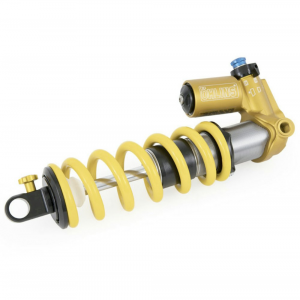
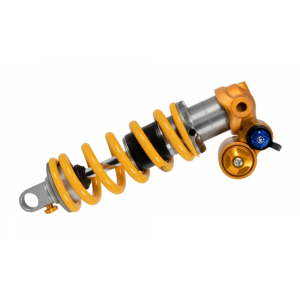
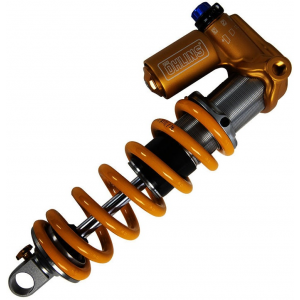
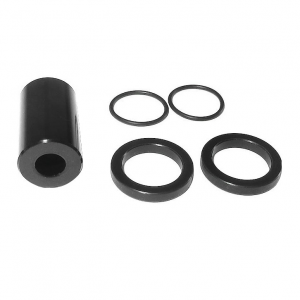



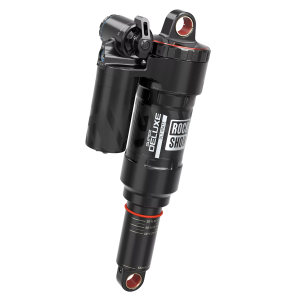

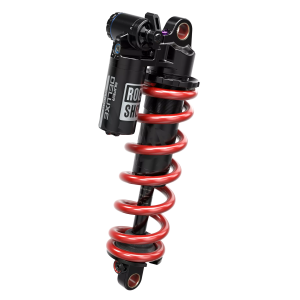











10 comments
Post a reply to: First Ride: Öhlins TTX Shock - Yellow Gold